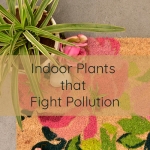- November 6, 2019
- 0 Comments
- skyy-blog
Pollution levels in our country are at such high levels that some compare it to a ‘gas chamber’. The levels of pollution across the country are varied but still extremely high compared to other countries.
While we talk about the PM2.5 levels that we’re breathing outside our houses, we don’t realize that indoor pollution levels are actually significantly higher than outside.
Most of us in cities like Delhi have invested in air purifiers for indoors and masks for outdoors. But there are other options available which are less expensive and more appealing to the eye. There are a number of indoor plants that help clean the air in your homes and offices.
Let’s have a look at what’s causing the indoor pollution levels
- Formaldehyde, which is found on carpets and particle boards. Change to jute rugs and jute carpets wherever possible for a cleaner living environment.
- Volatile Organic Compounds (VOCs) – these are solvents and chemicals that are used in perfumes, hair sprays, air fresheners and furniture polish
- Biological pollutants which constitute of dust, fungi, allergens
- Carbon monoxide and nitrogen dioxides
These contribute to symptoms like allergies, headaches, cancer, dizziness and nervous system disorders to name a few.
Indoor plants that help clean up the air indoors
Aloe Vera: This is a plant that doesn’t need taking care of and is easy to grow. It has the ability to filter benzene and formaldehyde. Besides the fact that it is good to clean the air in your home and office, it is also great to have around the house for a number of health reasons. It is full of vitamins, amino acids, and other compounds that have antibacterial, and anti-inflammatory properties.
Spider Plant: This has been named the best indoor plant to help remove formaldehyde from the air. It also helps with toxins like benzene, carbon monoxide and xylene. This is a resilient plant and doesn’t require you to have green thumbs.
Gerber Daisies: These bright and pretty flowers are not only beautiful to look at, but they are great for absorbing pollutants like carbon monoxide and benzene. This plant gives out oxygen at night, making it a good plant to have in your bedroom while you sleep.
Jade Plant: This plant is often referred to ask the ‘friendship plant’. It helps remove more than 80 per cent of benzene, toluene, ethylbenzene, p-Xylenes and o-Xylene. Tests have shown that it is the best plant for removing toluene pollution from indoors.
Dracaena: The leaves of this plant remove xylene, trichloroethylene and formaldehyde. There are a few varieties of this plant you can choose from. It needs some tending and should be put outdoors in the sun from time to time. If you have pets in the house, make sure they don’t consume the leaves of this plant. It is poisonous if consumed by pets.
Snake Plant/Mother in Law’s Tongue: This is one of the sturdiest houseplants you can keep. It helps remove pollutants like benzene, formaldehyde, trichloroethylene, and xylene. It takes in carbon dioxide and releases oxygen at night which makes it a good bedroom plant. It requires minimal sunlight.
Bamboo Plant: This plant is a natural humidifier and works best in areas with dry air. It helps eliminate carbon monoxide, xylene, benzene and formaldehyde. These houseplants thrive in shady indoor spaces and often produce small flowers and berries. One of the reasons why they are able to filter so much air is because of their size. They can grow to be pretty big.
One of the things you could additionally do is not to use plastic pots. Plastic also gives off gases which add to the pollutants in the air. Using organic soil also helps.
So now that you are equipped with information on how to make your home and environment safe, go plant shopping. Use the Skyy jute baskets for the potted plants and make your home pretty. They come in different combinations and sizes and are perfect additions to any corner of a house. http://skyyliving.comproduct-category/decor/baskets/



